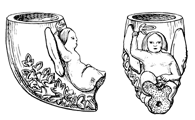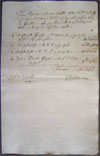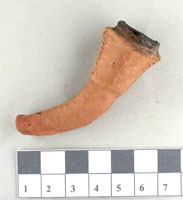 |
|
|
Ralf Kluttig-Altmann: |
|
|
|
|
|
|
Malgorzata Jaszczuk-Surma: |
|
|
|
|
||
|
Katarzyna Meyza: Fig.: Stub-stemmed pipes found in rubble and earth
|
|
|
|
|
||
|
|
Wojciech Siwiak:
|
|
|
|
||
|
Teresa Witkowska:
Fig.: Plan of the Rostin (Rostin) clay-pipe factory;
|
|
|
|
|
||
|
Martin Kügler: |
|
|
|
|
||
|
Ilze Reinfelde: |
|
||
|
Fig. 1: 17th century Sir Walter Raleigh pipe of Dutch origin, found in Riga, Latvia. |
Zoom

Fig. 2: Decorated 19th century pipes found in Riga, Latvia.
|
||
|
Agne Civilyte/Linas Kvizikevicius/Saulius Sarcevicius:
|
|
||
|
Fig. 2: Glazed and unglazed pipe bowls from Vilnius (Vilno), Lithuania.
|
|||
|
Fig.: Pipes found in the Holy Barbara Cemetery, Tallinn, Estonia. |
Erki Russow: |
|
|
|
||
|
Gábor Tomka:
Zoom
|
|
|
|
|
||
|
Martin Kügler: |
Zoom
 Fig.: Customs-officer Wolschen's list of confiscated pipes,
|
|
|
|
||
|
Bernd Standke: Fig.: 17th century clay pipes from Halle.
|
|
|
|
|
||
|
|
Martin Kügler:
Fig. 1. Resolution adopted by the pipemakers' guild
to admit Johann Willes as journeyman pipemaker, dated 13 Jan. 1777.
|
|
|
|
||
|
|
Ralf Kluttig-Altmann/Martin Kügler: |
|
|
|
|
|
Ralf Kluttig-Altmann/Martin Kügler: |
|
|
|
|
New Finds |
||
|
|
Rüdiger Articus: |
|
|
|
Carsten Spindler: |
|
|
|
||
|
Brigitte Fettinger:
Fig.: Clay-pipe finds from the Alt-Scharnstein castle ruins.
|
|
 |
|
|
||
|
Fig.: Imported Dutch clay pipes and a pipe bearing
the coat of arms of Emden.
|
|
|
|
|
||
|
Ursel Beck/Gudrun Heinssen-Levens: |
|
|
|
|
||
| Maurice Raphaël: Clay-pipe finds from Fort de Bellegarde, Southern France The small number of pipes found in the well in the fortress of Le Bellegarde cannot possibly be representative of the pipes smoked by the soldiers during the long period in which they were stationed there. |
||
|
However, the pipes provide a clue as to the variety that might be found in the future. Some of the pipes originate from the near vicinity, e.g. from Saint-Quentin-la-Poterie or Palamos, Spain; but most have a more distant provenance such as the Netherlands, Saint Omer or Givet. Thus the pipes provide less information about the smoking habits of the inmates of the fort than about the markets of the relevant pipemakers.
Fig. 2: Pipe bowl from Palamos, first half 19th century. |
|
|
|
|
|
|
|
||
|
Fig.: Engraved briar pipe.
|
|
|
|
|
||
|
Arne Åkerhagen:
Fig: Nazi pipe
|
|
|
|
|
||
|
Fig. 1.: Plague pipe with feet,
|
Arne Åkerhagen: Two plague-pipes from the Tessin Two black clay pipes from the plague hospital in Bellinzona were probably intended to protect or cure the smoker(s) from the plague in the 17th and 18th centuries. The pipes have clearly been modelled by hand without the use of a mould. One of them has the unusual addition of feet at the base of the bowl; these would allow it to stand safely on a flat surface. The other pipe is marked with a large cross and "M J 1723", which were inscribed in the clay before firing. On the top of the stem is a large clay loop, which, however, is not connected to the bore of the stem. The black colour is clearly intentional and is uniform on the two pipes. Whether smoking these pipes really afforded some protection against the plague is, in view of present-day knowledge, more than doubtful. However, these two pipes give us an insight into the beliefs and hopes of people at the beginning of the 18th century, as well as into their attempts to escape from this dangerous disease. |
|
|
|
||
Fig.: Pipe stem from Sborovsky.
|
Rüdiger Articus: A pipestem from Sborovsky in Hamburg During excavations in the old part of Hamburg in 1995, a pipe stem inscribed with "SCHLES", indicating that it comes from Sborovsky (Zborowskie) in Upper Silesia, was picked up as a random find. This stem, which dates from the second half of the 18th century, is so far the only evidence that pipes from Upper Silesia found their way to Hamburg. |
|
|
|
||
|
Bernd Kramer:
Fig.: Christian Friedrich Hunold (1680-1721).
|
|
|
|
|
||
Home
KnasterKOPF
Society
Sitemap
Contact us
Impressum
last update: 2013-11-28